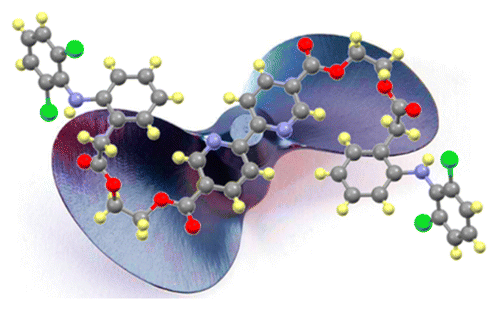Pairing pain medicine with metal ions to battle cancer

Fighting chemoresistant cancer remains a huge challenge that scientists are tackling from as many angles as they can. One alternative approach involves pairing two groups of compounds—pain medicine and metal ions—that have individually shown promise as anti-cancer agents. Scientists report in the ACS journal Inorganic Chemistry that combining the two led to new compounds that could destroy drug-resistant cancer cells and leave most normal cells alone in lab tests.
Using metal ions in cancer drugs has a relatively long history. Cisplatin, for example, is a platinum-based therapy that has been used for years against lung, ovary and other cancers. But often, resistance against the drug develops. Recent advances, however, are pointing to new ways to destroy cancer cells. Metal complexes other than platinum-based ones have emerged as potential cancer fighters. And studies have found that nonsteroidal anti-inflammatory drugs (NSAIDs) work against certain cancers and boost the activity of other drugs. Paul J. Dyson and colleagues decided to link the NSAIDs indomethacin and diclofenac with ruthenium and osmium ions to see if they could come up with an effective combination.
The researchers created several different NSAID-metal ion complexes, characterized their structures and tested them in the lab for their cancer-fighting potential. Some compounds were even more effective against ovarian cancer cells than cisplatin. And a few were significantly more toxic to cisplatin-resistant cells than to healthy cells, an important factor that could potentially reduce side effects down the road.
More information: Emilia Păunescu et al. Nonsteroidal Anti-inflammatory—Organometallic Anticancer Compounds, Inorganic Chemistry (2016). DOI: 10.1021/acs.inorgchem.5b02690
Abstract
Compounds that combine metal-based drugs with covalently linked targeted organic agents have been shown, in some instances, to exhibit superior anticancer properties compared to the individual counterparts. Within this framework, we prepared a series of organometallic ruthenium(II)- and osmium(II)-p-cymene complexes modified with the nonsteroidal anti-inflammatory drugs (NSAIDs) indomethacin and diclofenac. The NSAIDs are attached to the organometallic moieties via monodentate (pyridine/phosphine) or bidentate (bipyridine) ligands, affording piano-stool Ru(II) and Os(II) arene complexes of general formula [M(η6-p-cymene)Cl2(N)], where N is a pyridine-based ligand, {2-(2-(1-(4-chlorobenzoyl)-5-methoxy-2-methyl-1H-indol-3-yl)acetoxy)ethyl-3-(pyridin-3-yl)propanoate} or {2-(2-(2-((2,6-dichlorophenyl)amino)phenyl)acetoxy)ethyl-3-(pyridin-3-yl)propanoate}, [M(η6-p-cymene)Cl2(P)], where P is a phosphine ligand, {2-(2-(1-(4-chlorobenzoyl)-5-methoxy-2-methyl-1H-indol-3-yl)acetoxy)ethyl-4-(diphenylphosphanyl)benzoate} or {2-(2-(2-((2,6-dichlorophenyl)amino)phenyl)acetoxy)ethyl-4-(diphenylphosphanyl)benzoate, and [M(η6-p-cymene)Cl(N,N′)][Cl], where N,N′ is a bipyridine-based ligand, (4′-methyl-[2,2′-bipyridin]-4-yl)methyl-2-(1-(4-chlorobenzoyl)-5-methoxy-2-methyl-1H-indol-3-yl)acetate), (4′-methyl-[2,2′-bipyridin]-4-yl)methyl-2-(2-((2,6-dichlorophenyl)amino)phenyl)acetate), (bis(2-(2-(1-(4-chlorobenzoyl)-5-methoxy-2-methyl-1H-indol-3-yl)acetoxy)ethyl)[2,2′-bipyridine]-5,5′-dicarboxylate), or (bis(2-(2-(2-((2,6-dichlorophenyl)amino)phenyl)acetoxy)ethyl)[2,2′-bipyridine]-5,5′-dicarboxylate). The antiproliferative properties of the complexes were assessed in human ovarian cancer cells (A2780 and A2780cisR, the latter being resistant to cisplatin) and nontumorigenic human embryonic kidney (HEK-293) cells. Some of the complexes are considerably more cytotoxic than the original drugs and also display significant cancer cell selectivity.
Journal information: Inorganic Chemistry
Provided by American Chemical Society
















